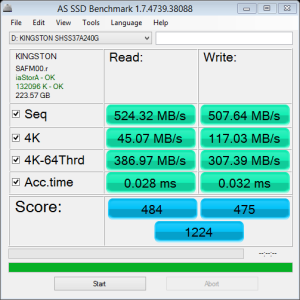The toughest benchmark available for solid state drives is AS SSD as it relies solely on incompressible data samples when testing performance. For the most part, AS SSD tests can be considered the ‘worst case scenario’ in obtaining data transfer speeds and many enthusiasts like AS SSD for their needs. Transfer speeds are displayed on the left with IOPS results on the right.
Our AS SSD result provided a Total Score of 1224. The HyperX Savage reaches a max of 524MB/s and 508MB/s for sequential read and write tests. 4K read and write reached 45MB/s and 117MB/s respectively. While 4K read speed is great, 4K write is on the low side compared to other high-end SSDs. In the IOPS we see it reaches a max of 99K IOPS read and 79K IOPS write.
To complement this, the AS SSD Copy Bench presents us with transfer speeds for different file types. The SSD reached a high of 483MB/s for the ISO test.
ANVIL STORAGE UTILITIES PROFESSIONAL
Anvil’s Storage Utilities (ASU) are the most complete test bed available for the solid state drive today. The benchmark displays test results for, not only throughput but also, IOPS and Disk Access Times. Not only does it have a preset SSD benchmark, but also, it has included such things as endurance testing and threaded I/O read, write and mixed tests, all of which are very simple to understand and use in our benchmark testing.
Anvil Storage Utilities shows similar results seen in the other benchmarks. This 240GB capacity reached a respectable score of 4,942 points. The max sequential read reached 526MB/s and sequential write came in at 504MB/s. 4K speeds reached 33MB/s read and 125MB/s write. In Anvil we were also able to see it reached 76K IOPS read and 90K IOPS write at a QD of 16.
Iometer is an I/O subsystem measurement and characterization tool for single and clustered systems. It was originally developed by the Intel Corporation, however, they discontinued work on the program. In 2003 it was re-launched by an international group of individuals who are now continuously improving, porting and extend the product that is now widely used within the industry. This is a very powerful benchmarking tool and we are just now starting to integrate it into our consumer reviews. At this point in time we are going to be running a 4KB random workload at QD32 for 30 seconds and show the average to measure performance.
While the HyperX Savage is rated for up to 100K IOPS read and 89K IOPS write, the write rating is when testing with only an 8GB partition or test file. We were able to achieve the IOPS ratings when testing with an 8GB test file, but we normally show the results from testing the entire SSD. Above are the results of testing the whole capacity with 4K writes at a queue depth of 32. We can see that this SSD does not do so well in terms of high QD writes when it spans the whole capacity and it is more optimized for read workloads. You should also note that while this doesn’t seem too great, it also doesn’t reflect real world usage performance. This benchmark is to simply test for the rated 4K random QD32 IOPS. Since it achieved the rated IOPS when tested in the same way Kingston did, we have to say it did a good job, we just wish it could reach its rated IOPS when the entire capacity was tested. This also shows how over provisioning can help increase a SSD’s performance. When testing a smaller portion of this SSD random write IOPs increase about 3x what we seen vs the whole capacity.
 The SSD Review The Worlds Dedicated SSD Education and Review Resource |
The SSD Review The Worlds Dedicated SSD Education and Review Resource | 


Thats gonna be a really though sell compared to 850evo, considering it costs almost as much as 850pro. And 850pro is king in sata6g space.
Kingston should have done better than this. Atleast use cheaper nand, if nothing else.
If history is any indication Kingston will end up using that cheaper NAND down the road but just not tell us. 🙂
A couple of other sites just came out with less positive reviews and they also address the yet to be fixed performance issue.
This is the beauty of independent reviews; one has the opportunity to compare several reports before purchase. As for our analysis, we try to paint the picture exactly as our testing portrays it and, especially when looking at PCMark 8, one needs to realize that the SSD just survived 18-22 hours of the hardest testing it will ever see, testing not intended for a typical consumer solution. It might be somewhat comparable to trying to put a Mustang through the Baja 1000 off road circuit.
OK so I was looking randomly at this review and saw your avatar!
I found my match!! hello there 😀
Hello there 🙂
I want that screwdriver!!
It looks awfully kitschy ? but it’s a decent SSD drive.